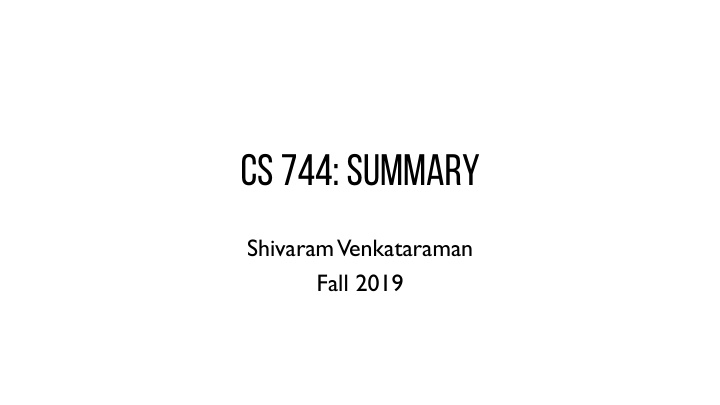



CS 744: SUMMARY Shivaram Venkataraman Fall 2019
Administrivia Midterm 2 on Tuesday • Poster session Dec 13 th , 3-5pm details on Piazza • • Final report Dec 17 th AEFIS Course feedback form! •
Applications Machine Learning SQL Streaming Graph Computational Engines Scalable Storage Systems Resource Management Datacenter Architecture Open Compute Project
OUTLINE Unification vs Specialization Survey results, Discussion Big data systems: Looking forward
SPECIALIZATION VS UNIFICATION
GENERALITY: “ONE SIZE FITS ALL” DBMS 1970s Research prototypes: SystemR and INGRES Main function: OLTP From 1990s Rise of business intelligence workloads OLAP workloads need to be isolated from OLTP Solution: Scrape data into data warehouses.
DBMS IMPLEMENTATION
STREAM PROCESSING ? Example: Financial feed processing (Bloomberg, Reuters)
EXAMPLE WORKLOAD Goals: Maximize message processing throughput on single machine Scenario: Stock tick is late is if it occurs more than X secs from previous tick Performance comparison: 2.8 GHz, 512 MB memory, single SCSI disk 160,000 messages per second with StreamBase 900 messages per second with DBMS
WHY IS IT SLOW ? DBMS: “Outbound” processing model 1. Insert data 2. Index data, commit transaction 3. Process query, return results Process after store
WHY IS IT SLOW ? “Inbound” data processing 1. Push inputs into system 2. Process query 3. Return results 4. Optionally store (async) Only way to do this in DBMS: Triggers Not performant
“Pull” records given query OUTBOUND Store data, run any query “Push” records into query INBOUND Store queries, pass data through
IS IT JUST STREAMING ? Sensor Networks: TinyDB Text Search: GFS / MapReduce Scientific databases: SciDB Data warehouses Column stores, read-oriented vs. write oriented
BIG DATA SYSTEms Unified systems Specialized systems
BENEFITS Unified systems Specialized systems
IS IT JUST A CYCLE ?
WHERE ARE WE IN THE CYCLE ? Dryad CIEL 2004 - 2011 2011 - 2015 2015 - now
BOOTSTRAPPING UNIFIED SYSTEMS ? 1. Implement a system/app/functionality that is superior to what is out there 2. Rapidly build an ecosystem providing additional functionalities Example: Tensorflow initially target SGD/deep learning Unifies number of other features - tf.data supporting map, flat_map etc. - tf.linalg implementing linear algebra - tf.sparse for sparse data / shallow models
SURVEY RESULTS
LEARNING OBJECTIVES At the end of the course you will be able to • Explain the design and architecture of big data systems Paper Review • Compare, contrast and evaluate research papers Discussion • Develop and deploy applications on existing frameworks Assignment Design, articulate and report new research ideas • Project
DISCUSSION https://forms.gle/sQFiAKwiQfHEKkPd8
What were some of your goals when you started the course? (Think about the first survey.) Reflect on what part of your goals have been achieved and how.
In the class, we discussed one trend across systems of unification vs. specialization. What are some other trends you have noticed across the papers in the class?
LOOKING FORWARD
NEXT-GENERATION BIG DATA SYSTEMS ? Workloads Data Processing Systems Hardware
TRENDS in WORKLOADS New functionalities Data science / AI Robotics Diversity ? New data sources Bio-medical data Video streams IoT / edge devices
Fairness in ML?
HOW ROBUST IS YOUR SYSTEM ? Adversarial examples
WHAT CAN SYSTEMS RESEARCH DO ? More than performance? Latency, throughput, efficiency Ease of use Some other goals to consider ? Security, Privacy Robustness Data bias / ethics
COURSE SUMMARY Large scale data analysis has changed the world
COURSE SUMMARY Your System Here ? Applications Machine Learning SQL Streaming Graph Computational Engines Scalable Storage Systems Resource Management
Recommend
More recommend